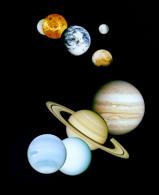 As darkness falls at the beginning of June, three planets will form a long line in the western sky. Saturn will be at the upper left, Mars in the middle and Venus at the lower right. Venus will form a straight line with the bright stars Pollux and Castor of the constellation Gemini the Twins on June 11 fairly low in the west-northwest. On June 19 and 20, the brilliant white planet will pass just north of the Beehive star cluster. Binoculars will show the stars twinkling while the planet gleams steadily.
As darkness falls at the beginning of June, three planets will form a long line in the western sky. Saturn will be at the upper left, Mars in the middle and Venus at the lower right. Venus will form a straight line with the bright stars Pollux and Castor of the constellation Gemini the Twins on June 11 fairly low in the west-northwest. On June 19 and 20, the brilliant white planet will pass just north of the Beehive star cluster. Binoculars will show the stars twinkling while the planet gleams steadily.To Venus's upper left (south) will be red-orange Mars, making a colorful contrast with nearby blue-white Regulus, the brightest star of the constellation Leo the Lion. The colors will appear most vivid through binoculars. Mars and Regulus will be closest on June 6, but they will remain near each other for the first half of the month.
Venus will form a straight line with the bright stars Pollux and Castor of the constellation Gemini the Twins on June 11 fairly low in the west-northwest. On June 19 and 20, the brilliant white planet will pass just north of the Beehive star cluster. Binoculars will show the stars twinkling while the planet gleams steadily.
To Venus's upper left (south) will be red-orange Mars, making a colorful contrast with nearby blue-white Regulus, the brightest star of the constellation Leo the Lion. The colors will appear most vivid through binoculars. Mars and Regulus will be closest on June 6, but they will remain near each other for the first half of the month.
Saturn will materialize high in the southwest at dusk, setting around 2 a.m. local time at the start of the month and by midnight at month's end. Saturn's rings will appear to open slightly this month as seen from Earth, after being tilted nearly edgewise in late May. Mars and Venus will close in on Saturn from the lower right (west) as the month advances.
While Saturn is setting in the west, Jupiter will be rising in the east. Jupiter is a favorite target of observers with telescopes, because its rapid rotation causes its features to change position noticeably in as little as 10 minutes. Its four largest moons -- Io, Europa, Ganymede and Callisto -- will be visible in binoculars or any telescope, changing positions from night to night as they patrol east and west of the planet in their orbits. Occasionally one or more of them will disappear as they pass in front of Jupiter or behind it. These moons are bright enough that you could see them without optical aid if it weren't for Jupiter's brilliance. The planet will climb higher in the southeast during June, and views of it will improve quickly.

 Previous page
Previous page Back to top
Back to top







